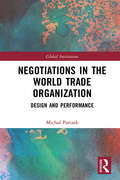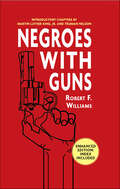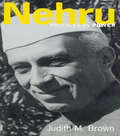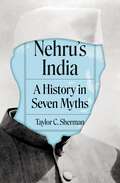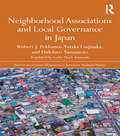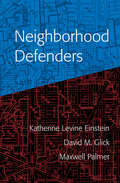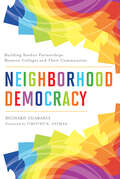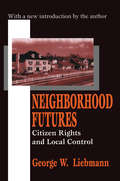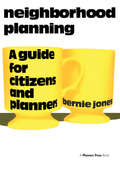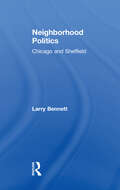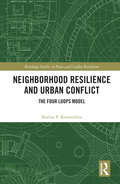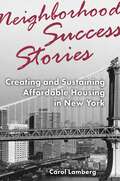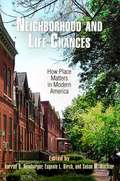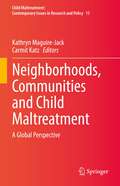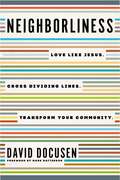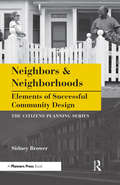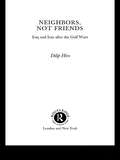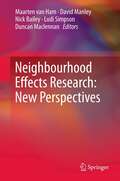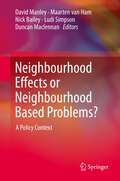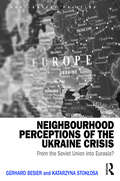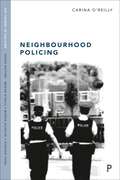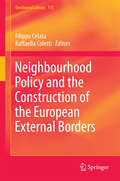- Table View
- List View
Negotiations in the World Trade Organization: Design and Performance (Global Institutions)
by Michal ParizekThis book examines the World Trade Organization (WTO) in the context of the global economy in the twenty-first century, arguing that many problems within the institution lie in the disparity between its design and the nature of its tasks. Studying the global trade regime and the unsuccessful Doha round of trade liberalization negotiations, this volume suggests that important institutional adjustments may be necessary for the WTO and other major international institutions to (re-)gain their ability to manage global economy. It uses extensive new qualitative and quantitative evidence to identify systematic dysfunctions in how the Doha negotiations have been conducted and links these dysfunctions to the exclusively inter-governmental design of interest representation in the WTO. Based on this, the book argues that global economic institutions should consider allowing broader parliamentary and non-state representation of their members. Presenting findings which can also be applied to other global economic institutions, Negotiations in the World Trade Organization will be useful to students and scholars of international trade, global governance and international political economy.
Negro President: Jefferson and the Slave Power
by Garry Willsn "Negro President," the best-selling historian Garry Wills explores a controversial and neglected aspect of Thomas Jefferson's presidency: it was achieved by virtue of slave "representation," and conducted to preserve that advantage. Wills goes far beyond the recent revisionist debate over Jefferson's own slaves and his relationship with Sally Heming to look at the political relationship between the president and slavery. Jefferson won the election of 1800 with Electoral College votes derived from the three-fifths representation of slaves, who could not vote but who were partially counted as citizens. That count was known as "the slave power" granted to southern states, and it made some Federalists call Jefferson the Negro President -- one elected only by the slave count's margin. Probing the heart of Jefferson's presidency, Wills reveals how the might of the slave states was a concern behind Jefferson's most important decisions and policies, including his strategy to expand the nation west. But the president met with resistance: Timothy Pickering, now largely forgotten, was elected to Congress to wage a fight against Jefferson and the institutions that supported him. Wills restores Pickering and his allies' dramatic struggle to our understanding of Jefferson and the creation of the new nation. In "Negro President," Wills offers a bold rethinking of one of American history's greatest icons.
Negroes with Guns
by Robert F. WilliamsThe Quintessential Exploration of the Role of Violence in Protecting Civil Rights This enhanced edition includes an index. "I do not advocate violence for its own sake, or for the sake of reprisals against whites. Nor am I against the passive resistance advocated by the Reverend Martin Luther King," Robert F. Williams wrote in his prologue to Negroes with Guns. "But where there is a breakdown of the law, the individual citizen has a right to protect his person, his family, his home and his property." In 1961 Mr Williams led his Monroe, North Carolina community to arm themselves in the face of racist violence. This book spells out his belief that the ability to defend oneself is a legal right which could prevent racist incidents from occurring, and that self-defense compelled law enforcement agencies into action. "The lawful authorities of Monroe and North Carolina acted to enforce order . . . as a direct result of us being armed." As a result of his movement, Williams was vilified and framed, and subsequently fled the country, but his account of his struggle for the rights White America takes for granted remains a searing testimony to the racism which continues to plague the nation to this day. This book vividly captures effect of the debate in the Black community between non-violent and violent defense of civil rights as it played out in the 1960s. Williams graphically details his ongoing struggle with the Ku Klux Klan and the black community's attempt at armed defense. Framing this struggle in a wider context are essays on non-violence by the Reverend Martin Luther King, Jr., and abolitionist scholar Truman Nelson, who discusses the divergent views of King and Williams.
Nehru (Profiles In Power)
by Judith M. BrownJudith Brown explores Nehru as a figure of power and provides an assessment of his leadership at the head of a newly independent India with no tradition of democratic politics.
Nehru's India: A History in Seven Myths
by Taylor C. ShermanAn iconoclastic history of the first two decades after independence in IndiaNehru’s India brings a provocative but nuanced set of new interpretations to the history of early independent India. Drawing from her extensive research over the past two decades, Taylor Sherman reevaluates the role of Jawaharlal Nehru, India’s first prime minister, in shaping the nation. She argues that the notion of Nehru as the architect of independent India, as well as the ideas, policies, and institutions most strongly associated with his premiership—nonalignment, secularism, socialism, democracy, the strong state, and high modernism—have lost their explanatory power. They have become myths.Sherman examines seminal projects from the time and also introduces readers to little-known personalities and fresh case studies, including India’s continued engagement with overseas Indians, the importance of Buddhism in secular India, the transformations in industry and social life brought about by bicycles, a riotous and ultimately doomed attempt to prohibit the consumption of alcohol in Bombay, the early history of election campaign finance, and the first state-sponsored art exhibitions. The author also shines a light on underappreciated individuals, such as Apa Pant, the charismatic diplomat who influenced foreign policy from Kenya to Tibet, and Urmila Eulie Chowdhury, the rebellious architect who helped oversee the building of Chandigarh.Tracing and critiquing developments in this formative period in Indian history, Nehru’s India offers a fresh and definitive exploration of the nation’s early postcolonial era.
Neighborhood Associations and Local Governance in Japan (Nissan Institute/Routledge Japanese Studies)
by Yutaka Tsujinaka Robert J. Pekkanen Hidehiro YamamotoAlthough local neighborhood associations are found in many countries, Japan’s are distinguished by their ubiquity, scope of activities, and very high participation rates, making them important for the study of society and politics. Most Japanese belong to one local neighborhood association or another, making them Japan’s most numerous civil society organization, and one that powerfully shapes governance outcomes in the country. And, they also often blur the state-society boundary, making them theoretically intriguing. Neighborhood Associations and Local Governance in Japan draws on a unique and novel body of empirical data derived from the first national survey of neighborhood associations carried out in 2007 and provides a multifaceted empirical portrait of Japan’s neighborhood associations. It examines how local associational structures affect the quality of local governance, and thus the quality of life for Japan’s citizens and residents, and illuminates the way in which these ambiguous associations can help us refine civil society theory and show how they contribute to governance. As well as outlining the key features of neighbourhood associations, the book goes on to examine in detail the way in which neighbourhood associations contribute to governance, in terms of social capital, networks with other community organizations, social service provision, cooperation with local governments and political participation. This book will be welcomed by students and scholars of Japanese politics, Japanese society, anthropology, urban studies as well as those interested in social capital and civil society.
Neighborhood Defenders: Participatory Politics and America's Housing Crisis
by Katherine Levine Einstein David M. Glick Maxwell PalmerSince the collapse of the housing market in 2008, demand for housing has consistently outpaced supply in many US communities. The failure to construct sufficient housing - especially affordable housing - in desirable communities and neighborhoods comes with significant social, economic, and environmental costs. This book examines how local participatory land use institutions amplify the power of entrenched interests and privileged homeowners. The book draws on sweeping data to examine the dominance of land use politics by 'neighborhood defenders' - individuals who oppose new housing projects far more strongly than their broader communities and who are likely to be privileged on a variety of dimensions. Neighborhood defenders participate disproportionately and take advantage of land use regulations to restrict the construction of multifamily housing. The result is diminished housing stock and higher housing costs, with participatory institutions perversely reproducing inequality.
Neighborhood Democracy: Building Anchor Partnerships Between Colleges and Their Communities
by Richard GuarasciPublished in association with Higher education and America stand at a perilous moment brought about by economic and social inequality, racism, and the fracture of civic cohesion and structures.From its origins, the mission of American higher education was to promote democratic governance and a free, fair, and orderly society through the education of responsible citizens. Just as its mission has become more urgent, it is being undermined as colleges and universities find themselves trapped in a fiscal crisis that threatens their very institutional viability—a crisis in large part brought about by the very perpetuation of economic and racial inequity, and the consequent erosion of consensus about civic purpose and vision.This book argues that higher education can and must again take leadership in promoting the participatory processes and instilling the democratic values needed to build a vibrant and fair society. How to do that when, as Guarasci argues, a majority of colleges and universities are floundering under a business model that generates insufficient net revenue while making college unaffordable?Guarasci offers a model of civic mission and engagement whereby, through relatively modest investment, colleges can develop reciprocal partnerships with local institutions, civic, and business groups to raise the quality and outcomes of K-12 education, promote local entrepreneurship and community involvement, raise incomes, and increase the attainment of postsecondary education to benefit the wider national economy and colleges around the region and country. He demonstrates how civic engagement can revitalize communities and generate developmental and foundation funding.Vividly illustrated by the examples of success of students from the shadow community to which Wagner College committed its energies and resources, by the stories of the local schools and their principals, and the voices of local partners, this book offers a compelling and detailed account of what it takes to transform an institution and a neighborhood—and a model of renewal.
Neighborhood Futures: Citizen Rights and Local Control
by George W. LiebmannTwo conflicting developments have recently characterized civic life in the United States. The first, the centralization of formal agencies of government, too often leads to diminishing political liberties and tyranny. The second, which is characterized by a greater amount of civic participation and individual self-actualization, is the formation of a whole new layer of sublocal institutions, both public and private. These include residential community and condominium associations; property owner-based business improvement districts in nearly all major cities; neighborhood improvement districts in large cities; and even self-governing public schools. Neighborhood Futures is a realistic exploration of how, for a society to move forward and improve, its citizens must exercise the power to act creatively, and feel they are both competent and responsible individuals. Supporting his ideas with the Dutch innovation of the woonerf, or neighborhood street government, Liebmann follows through by discussing other foreign models of civic life forms and illustrating how they have resulted in resident satisfaction. George W. Liebmann is a partner of Liebmann & Shively, P.A., a Baltimore law firm that specializes in local government and education law. In addition to having served as a top aide to one of Maryland's governors, he is a former faculty associate of the Lincoln Institute of Land Policy, and is the author of Little Platoons and The Gallows in the Grove.
Neighborhood Planning: A Guide for Citizens and Planners
by Bernie JonesFirst published in 1990. Routledge is an imprint of Taylor & Francis, an informa company. This guide explains neighborhood planning for both citizens and professionals. It explains what information to collect, where to get it, and how to assess it; how to pinpoint key issues, set clear goals, and devise strategies to achieve them; and how to package, implement, and update the final plan. Although this book could be used by citizens working alone, Jones advocates a team approach—citizens and professionals planning together. He highlights which tasks are best suited to the professional and how the planner should manage his role as intermediary between the city administration and residents. Jones also takes a detailed look at the neighborhood plan itself. Numerous maps illustrate how to inventory environmental features, land uses, circulation systems, and design features.
Neighborhood Politics: Chicago and Sheffield
by Larry BennettFirst Published in 1997. Routledge is an imprint of Taylor & Francis, an informa company.
Neighborhood Resilience and Urban Conflict: The Four Loops Model (Routledge Studies in Peace and Conflict Resolution)
by Karina V. KorostelinaThis book explores the resilience in urban neighborhoods affected by chronic conflict and violence, developing a new model for improving resilience policies. The neighborhood resilience approach is an inclusive form of building positive resilience, which recognizes that local communities possess valuable skills and experience of dealing with crises, and prioritizes the agency of local communities in the production of knowledge and developing practices. The book identifies and describes the repertoire of neighborhood resilience practices organized in four clusters: (1) addressing the structure of conflict; (2) increasing the effectiveness of external resources; (3) enhancing the community capacities; and (4) reflecting the dynamics of identity and power in neighborhoods. One of the key findings of the book is the nonlinear connections between structure and dynamics of conflict and neighborhood resilience practices represented in the Four Loops Model. The concentration on community-based practices addresses macro-level critiques of neo-liberalism in critical resilience studies and encourages rethinking the ways community-based indicators might operate in combination with existing macro indicators of resilience. The bottom-up indicators provide more specific details and essential localized experiences for improving resilience policies at the national level. This book will be of much interest to students of conflict resolution, resilience, urban studies, and US politics.
Neighborhood Success Stories: Creating and Sustaining Affordable Housing in New York
by Carol LambergThe high cost of building affordable housing in New York, and cities like it, has long been a topic of urgent debate. Yet despite its paramount importance and the endless work of public and private groups to find ways to provide it, affordable housing continues to be an elusive commodity in New York City—and increasingly so in our current economic and political climate. In a timely, captivating memoir, Carol Lamberg weighs in on this vital issue with the lessons she learned and the successes she won while working with the Settlement Housing Fund, where she was executive director from 1983 until 2014. Lamberg provides a unique perspective on the great changes that have swept the housing arena since the curtailment of the welfare state in the 1970s, and spells out what is needed to address today’s housing problems. In a tradition of “big city” social work memoirs stretching back to Jane Addams, Lamberg reflects on the social purpose, vision, and practical challenges of the projects she’s been involved in, while vividly capturing the life and times of those who engaged in the creation and maintenance of housing and those who have benefited from it. Using a wealth of interviews with managers and residents alike, alongside the author’s firsthand experiences, this book depicts examples of successful community development between 1975 and 1997 in the Bronx and on the Lower East Side of Manhattan. In the “West Bronx Story,” Lamberg details the painful but ultimately exhilarating development of eighteen buildings that comprise New Settlement Apartments—a dramatic transformation of a devastated neighborhood into a thriving community. In “A Tale of Two Bridges,” the author depicts a different path to success, along with its particular challenges. The redevelopment of this area on the Lower East Side involved six different Federal housing programs and consisted of six residential sites, a running track, and a large scale supermarket. To this day, forty years later, all the buildings remain strong. With Neighborhood Success Stories, Lamberg offers a roadmap to making affordable housing a reality with the key ingredients of dogged persistence, group efforts, and creative coalition building. Her powerful memoir provides hope and practical encouragement in times that are more challenging than ever.
Neighborhood and Life Chances: How Place Matters in Modern America (The City in the Twenty-First Century)
by Eugenie L. Birch Susan M. Wachter Harriet B. NewburgerDoes the place where you lived as a child affect your health as an adult? To what degree does your neighbor's success influence your own potential? The importance of place is increasingly recognized in urban research as an important variable in understanding individual and household outcomes. Place matters in education, physical health, crime, violence, housing, family income, mental health, and discrimination—issues that determine the quality of life, especially among low-income residents of urban areas.Neighborhood and Life Chances: How Place Matters in Modern America brings together researchers from a range of disciplines to present the findings of studies in the fields of education, health, and housing. The results are intriguing and surprising, particularly the debate over Moving to Opportunity, an experiment conducted by the Department of Housing and Urban Development, designed to test directly the effects of relocating individuals away from areas of concentrated poverty. Its results, while strong in some respects, showed very different outcomes for boys and girls, with girls more likely than boys to experience positive outcomes. Reviews of the literature in education and health, supplemented by new research, demonstrate that the problems associated with residing in a negative environment are indisputable, but also suggest the directions in which solutions may lie.The essays collected in this volume give readers a clear sense of the magnitude of contemporary challenges in metropolitan America and of the role that place plays in reinforcing them. Although the contributors suggest many practical immediate interventions, they also recognize the vital importance of continued long-term efforts to rectify place-based limitations on lifetime opportunities.
Neighborhoods, Communities and Child Maltreatment: A Global Perspective (Child Maltreatment #15)
by Carmit Katz Kathryn Maguire-JackThis volume explores methods for studying child maltreatment in the context of neighborhoods and communities, given their importance in the lives of families. It discusses the ways in which neighborhoods have changed over time and how this that has impacted parenting in the modern context. It also highlights the ways in which policies have contributed to persistent poverty and inequality, which indirectly impacts child maltreatment. An important focus of this volume is to examine the multitude of ways in which the neighborhood context affects families, including structural factors like poverty, segregation, residential instability, and process factors like social cohesion. The volume takes a critical look at the ways in which culture and context affect maltreatment through a community-based approach, and uses this approach to understand child maltreatment in rural areas. The editors and contributors explore innovative prevention approaches and reflect on the future of this field in terms of what remains unknown, how the information should be used to guide policy in the future, and how practitioners can best support parents while being mindful of the importance of context. Addressing an important topic, this volume is of relevance and interest to a wide readership of scholars and students in the social and behavioral sciences, as well as to practitioners and policy makers working with neighborhoods and communities.
Neighborhoods, Family, and Political Behavior in Urban America: Political Behavior & Orientations (Contemporary Urban Affairs)
by Yvette Alex-AssensohUndergirded by a multidisciplinary framework of political science, geography, and sociology, this book examines hte manner in which neighborhood economic resources and family structure shape individual political behavior among white and black citizens in urban America.
Neighborliness: Love Like Jesus. Cross Dividing Lines. Transform Your Community.
by David DocusenDo you want to love your neighbor as yourself but don&’t know where to start? This practical, accessible guide to bridging the dividing lines of politics, race, and economics, both individually and as the church, will help you amplify Jesus in your community and build God&’s kingdom. When asked what the greatest commandment is, Jesus gave a two-part answer: &“Love the Lord your God with all your heart and with all your soul and with all your mind and with all your strength&” and also &“Love your neighbor as yourself.&” Love God. Love others. Jesus&’ simple command to love your neighbor can feel overwhelming when your neighbor looks, lives, and votes differently than you do. Racial and economic tensions across the country have resulted in deep dividing lines that seem really intimidating to cross. Docusen breaks down these lines in approachable chapters, including topics like these: how to actively seek out people you can benefit and encourage,what it means to find a diverse and supportive community that fulfills needs, examples of real-life experiences, including highlights and missteps of Docusen&’s ongoing journey, andhow churches can teach on difficult topics with grace and truth.Neighborliness is a practical guide to bridging those dividing lines and learning to recognize and amplify the beauty of God in our communities. Backed by David&’s speaking and training through the Neighborliness Center, this book will help individuals and churches reach out to their neighbors, love them through Christ, and build God&’s kingdom.
Neighbors In Need: Zimbabweans Seeking Refuge in South Africa
by Human Rights WatchThis 119-page report examines South Africa's decision to treat Zimbabweans merely as voluntary economic migrants and its failure to respond effectively to stop the human rights abuses and economic deprivation in Zimbabwe that cause their flight and to address their needs in South Africa. Human Rights Watch spoke to almost 100 Zimbabweans in South Africa about their plight.
Neighbors and Neighborhoods: Elements of Successful Community Design
by Sidney BrowerHow does the design of a neighborhood affect the people who live there? In this thoughtful, engaging book, the author explains how a neighborhood’s design lays the groundwork for the social relationships that make it a community. Blending social science with personal interviews, the author shares the lessons of planned communities from historic Riverside, Illinois, to archetypal Levittown, New York, and Disney’s Celebration, Florida. Through these inspirational stories, readers will discover the characteristics of neighborhoods that promote the attitudes and behaviors of a healthy community. This volume is an eye-opener for everyone who’s wondered what makes their local neighborhoods tick. It demystifies the way planners, architects, developers, organizers, and citizens come together in crafting a community’s physical elements, policies, programs, and processes. Readers will come away with a new understanding of their roles in creating the communities they want.
Neighbors, Not Friends: Iraq and Iran after the Gulf Wars
by Dilip HiroThis highly controversial and topical book provides the first full, balanced account of how Iraq cheated the UN inspectors on disarmament and how the US manipulated and infiltrated the UN inspection teams and other staff to gather intelligence on Iraq to overthrow Saddam Hussein. Aimed at the general reader, it follows and assesses the role of Saddam Hussein who became president of Iraq in 1979. Dilip Hiro, an experienced journalist who has written extensively on the region, provides a historical and accessible perspective to the relationship between Iraq and Iran and examines the consequences of internationally significant events such as the death of Ayatollah Khomeini in Iran a year after the end of the 1980-88 Iran-Iraq War and the 1990 invasion of Kuwait by Saddam Hussein. Providing a full account and analysis of events in Iraq since the 1991 Gulf War, he contrasts the long totalitarianism under Hussein with the evolution of the political-religious system in Iran and the development of its internal politics. This is an essential overview to the conflicts in the Gulf, and should be read by anyone with an interest in the region, its politics and its interactions with the US and UN.
Neighbourhood Effects Research: New Perspectives
by Nick Bailey Duncan Maclennan Ludi Simpson Maarten Van Ham David ManleyOver the last 25 years a vast body of literature has been published on neighbourhood effects: the idea that living in more deprived neighbourhoods has a negative effect on residents' life chances over and above the effect of their individual characteristics. The volume of work not only reflects academic and policy interest in this topic, but also the fact that we are still no closer to answering the question of how important neighbourhood effects actually are. There is little doubt that these effects exist, but we do not know enough about the causal mechanisms which produce them, their relative importance in shaping individual's life chances, the circumstances or conditions under which they are most important, or the most effective policy responses. Collectively, the chapters in this book offer new perspectives on these questions, and refocus the academic debate on neighbourhood effects. The book enriches the neighbourhood effects literature with insights from a wide range of disciplines and countries.
Neighbourhood Effects or Neighbourhood Based Problems?: A Policy Context
by Nick Bailey Duncan Maclennan Ludi Simpson Maarten Van Ham David ManleyThis edited volume critically examines the link between area based policies, neighbourhood based problems, and neighbourhood effects: the idea that living in disadvantaged neighbourhoods has a negative effect on residents' life chances over and above the effect of their individual characteristics. Over the last few decades, Western governments have persistently pursued area based policies to fight such effects, despite a lack of evidence that they exist, or that these policies make a difference. The first part of this book presents case studies of perceived neighbourhood based problems in the domains of crime; health; educational outcomes; and employment. The second part of the book presents an international overview of the policies that different governments have implemented in response to these neighbourhood based problems, and discusses the theoretical and conceptual processes behind place based policy making. Case studies are drawn from a diverse range of countries including the United Kingdom, The Netherlands, Australia, Canada, and the USA.
Neighbourhood Perceptions of the Ukraine Crisis: From the Soviet Union into Eurasia? (Post-Soviet Politics)
by Gerhard Besier Katarzyna StokłosaRecent events in Ukraine and Russia and the subsequent incorporation of Crimea into the Russian state, with the support of some circles of inhabitants of the peninsula, have shown that the desire of people to belong to the Western part of Europe should not automatically be assumed. Discussing different perceptions of the Ukrainian-Russian war in neighbouring countries, this book offers an analysis of the conflicts and issues connected with the shifting of the border regions of Russia and Ukraine to show how ’material’ and ’psychological’ borders are never completely stable ideas. The contributors – historians, sociologists, anthropologists and political scientists from across Europe – use an interdisciplinary and comparative approach to explore the different national and transnational perceptions of a possible future role for Russia.
Neighbourhood Policing: Context, Practices and Challenges
by Carina O'ReillyNeighbourhood policing has been called the 'cornerstone of British policing' but changing demand, pressures on funding and the cyclical nature of political support mean that this approach is under considerable pressure. Locating neighbourhood policing in its social and political context, the book investigates whether this UK model – intended to build confidence and legitimacy – has been successful. Exploring effective policing strategies and the importance of funding and philosophical support, it concludes with an assessment of the model’s future and the challenges that it needs to overcome.
Neighbourhood Policy and the Construction of the European External Borders
by Filippo Celata Raffaella ColettiThis book looks both backward and forward with regard to the European Union's political strategies towards its neighbouring countries. By bringing together the perspectives of critical geopolitics, policy studies and border studies, it presents a comprehensive review of the European Neighbourhood Policy and how it impacts the ongoing construction of the EU's external frontiers. Is the EU committed to promoting integration in a 'wider' European space, or is a "fortress Europe" emerging where the strengthening of internal cohesion is coupled with the militarisation of its external borders? The book aims to problematize this question by showing how the EU's external policies are based on a mixture of openness and closure, inclusion and exclusion, cooperation and securitisation. The European Neighbourhood Policy is a controversial strategy where regionalization and bordering, homogenisations and differentiations, centrifugal and centripetal forces proceed side-by-side, in an explicit attempt to construct a selective, mobile and fragmented border. A specific focus is devoted to the diversity of geo-strategies the EU is pursuing in its neighbouring countries and regions, macro-regional strategies and cross-border cooperation initiatives as new scales of cooperation, and the role of other global players.
